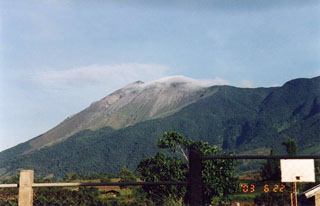Report on Kanlaon (Philippines) — 16 April-22 April 2025
Smithsonian Institution / US Geological Survey
Weekly Volcanic Activity Report, 16 April-22 April 2025
Managing Editor: Sally Sennert.
Please cite this report as:
Global Volcanism Program, 2025. Report on Kanlaon (Philippines) (Sennert, S, ed.). Weekly Volcanic Activity Report, 16 April-22 April 2025. Smithsonian Institution and US Geological Survey.
Kanlaon
Philippines
10.4096°N, 123.13°E; summit elev. 2422 m
All times are local (unless otherwise noted)
The Philippine Institute of Volcanology and Seismology (PHIVOLCS) reported continuing eruptive activity at Kanlaon during 16-22 April. The seismic network recorded 1-16 daily volcanic earthquakes and two periods of volcanic tremor (34 and 42 minutes long) on 15 April. Daily sulfur dioxide emissions ranged from 1,170 to 3,078 tonnes per day. Gas-and-steam emissions that occasionally contained ash generally rose as high as 200 m above the crater rim and drifted SW, W, and WNW. There were two ash emissions on 15 April (20 and 70 minutes long), and another on 20 April (31 minutes long); voluminous gas-and-ash plumes rose 600 m above the rim and drifted SW on 20 April. The Alert Level remained at 3 (on a scale of 0-5); the public was warned to stay 6 km away from the summit and pilots were warned not to fly close to the volcano.
Geological Summary. Kanlaon volcano (also spelled Canlaon) forms the highest point on the Philippine island of Negros. The massive andesitic stratovolcano is covered with fissure-controlled pyroclastic cones and craters, many of which are filled by lakes. The largest debris avalanche known in the Philippines traveled 33 km SW from Kanlaon. The summit contains a 2-km-wide, elongated northern caldera with a crater lake and a smaller but higher active vent, Lugud crater, to the south. Eruptions recorded since 1866 have typically consisted of phreatic explosions of small-to-moderate size that produce minor local ashfall.
Source: Philippine Institute of Volcanology and Seismology (PHIVOLCS)

